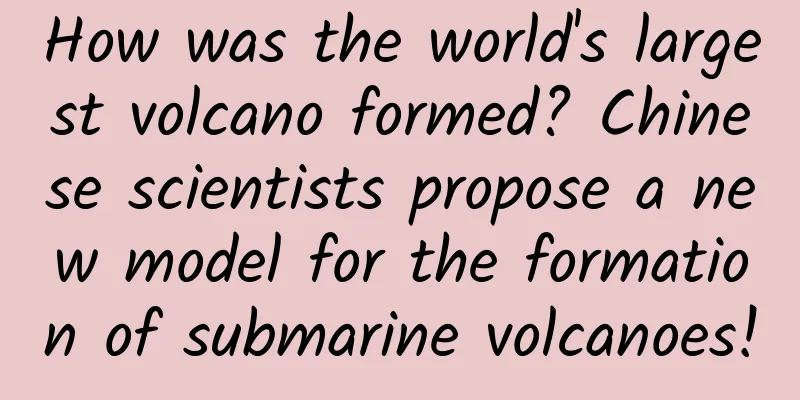How was the world's largest volcano formed? Chinese scientists propose a new model for the formation of submarine volcanoes!

|
Recently, Zhang Jinchang, a researcher at the South China Sea Institute of Oceanology, Chinese Academy of Sciences, and his international cooperation team have made another major breakthrough in the study of the formation mechanism of the largest single volcano on Earth, the Tamu volcano, revealing that the interaction between the mantle plume and the mid-ocean ridge is a new model for the formation of this submarine volcano. On Xth, 2023, the results were published in the top international academic journal Nature Geoscience. Tamu Massif is a dead volcano on the seafloor of the western Pacific Ocean, located in the Shatsky Rise area about 1,000 kilometers east of Japan. It covers an area equivalent to the combined area of Guangdong and Guangxi provinces, accounting for more than 60% of the entire Shatsky Rise. The Shatsky Rise is the world's third largest ocean floor plateau, second only to the Ontong Java Plateau in the Pacific Ocean and the Kerguelen Plateau in the Indian Ocean. Both are typical large igneous provinces in the ocean, that is, super volcanic eruption areas. ▲Distribution of the world's three largest ocean floor plateaus (Photo provided by the research team) There has been controversy in the scientific community about the formation mechanism of Tamun Volcano and Shatsky Rise. There are two main views: (1) the mantle plume model, which holds that large-scale magmatic activity is caused by high-temperature mantle plumes originating from deep in the mantle rising to the surface; (2) the plate model, which holds that large-scale magmatic activity is caused by decompression melting of the abnormally fusible upper mantle under the background of seafloor spreading, similar to mid-ocean ridges, without the need for obvious temperature anomalies. Since the last century, our predecessors have conducted marine scientific expeditions on the Shatsky Rise and accumulated a wealth of geophysical exploration and rock sampling data. The academic community is also constantly looking for scientific evidence to support the mantle plume model or plate model to resolve the debate about its formation mechanism. The discovery of Tamu Big was announced in September 2013. Zhang Jinchang and his team of collaborators analyzed seismic detection and ocean drilling data and pointed out that the shield-shaped Tamu Big is the largest single volcano on Earth, not only surpassing the Mauna Loa volcano in Hawaii, but also comparable to the Olympus Mons on Mars. And the overflow basalt structure on the volcano conforms to the model of a mantle plume erupting supervolcano. Subsequently, their team went out to sea again to conduct detailed geomagnetic measurements of the Tamu Big. In 2019, analysis of geomagnetic data revealed that the interior of the Tamu Big volcano has banded magnetic anomaly characteristics, which coincides with the geomagnetic characteristics of the mid-ocean ridge formed by seafloor expansion and is consistent with the plate model. These two results were published in the journal Nature Geoscience in 2013 and 2019, respectively. ▲Map of the seafloor topography of the Tamu volcano (provided by the research team) But what is puzzling is that both the mantle plume and plate tectonics models are supported by the above-mentioned important evidence, and it is difficult to distinguish between the two. In other words, neither model can solve the problem of the origin of the Tamu volcano alone. Therefore, it is urgent to establish an alternative model to better explain the existing observations. Therefore, Zhang Jinchang and his team used a thermodynamic-chemical numerical simulation method to establish two test models for the formation mechanism of the Tamu volcano: the first is a single seafloor spreading model, and the second is a mantle plume-mid-ocean ridge interaction model. The simulation results show that the potential mantle temperature required for single seafloor spreading is much higher than the average mantle potential temperature of the global mid-ocean ridge system, which is unreasonable; while the mantle potential temperature estimated by the mantle plume-mid-ocean ridge interaction model is moderate and more reasonable. In addition, the mantle melting degree estimated by the mantle plume-mid-ocean ridge interaction model is consistent with the previous estimates based on geochemical elements. Therefore, it is concluded that the interaction between mantle plumes and mid-ocean ridges is the most reasonable model for the formation of the Tamu volcano. ▲Mechanism of formation of ocean floor plateau (Photo provided by the research team) Zhang Jinchang added: "The model of the interaction between mantle plumes and mid-ocean ridges is similar to the '1+1=2' effect, but how do mantle plumes 'add' to the mid-ocean ridges? This may involve the dynamic process of mantle plumes inducing mid-ocean ridge transitions, which is still lacking in-depth research." The study of Tamu Big also provides inspiration for the formation and evolution of global marine supervolcanoes. More and more research has revealed that supervolcanoes in the ocean are widely developed on or near mid-ocean ridges, such as the Ontong Java Plateau and Kerguelen Plateau mentioned above. This means that there is a strong connection between many ocean floor plateaus and mid-ocean ridges. So, is the interaction between mantle plumes and mid-ocean ridges a necessary condition for the formation of global ocean floor plateaus, or is Tamu Big just a special case? This global universal problem needs to be solved by more research in the future. In addition, in an earlier interview with Wanxiang Daily, researcher Zhang Jinchang also answered questions such as "What types of submarine volcanoes are there?", "Why submarine volcanoes are not extinguished by seawater?", "The importance of studying submarine volcanoes to us humans" and "How far are submarine volcanoes from us?" The following is the original interview text. Which is more dangerous, an underwater volcano or a land volcano? The locations of submarine volcanoes and volcanoes on land are different. Submarine volcanoes are volcanoes in the ocean. 30% of the earth is land, and 70% is ocean. According to this ratio, there should be more volcanoes in the ocean than on land. In geological terms, volcanoes on land are located in the continental crust, that is, the crust of the continents, while volcanoes in the ocean are located in the oceanic crust. The continental crust is relatively thick, relatively solid and stable; the crust in the ocean is relatively thin and more active. From this perspective, volcanoes in the ocean are more likely to erupt. In terms of disasters, there are many cities on land, they are very developed and the population is relatively dense. If a volcano erupts on land, the disasters to our economy, society, personal safety and property safety will definitely be more serious. What types of submarine volcanoes are there? According to different tectonic positions, submarine volcanoes can be roughly divided into three types. The solid layer (plate) on the surface of the earth floats on the asthenosphere and is movable, that is, the earth's plates can move. Among them, there are two types of volcanoes formed at the boundaries of plates. The first type is ocean ridge volcanoes, which are formed at the growth boundary of plates. When the plates expand, volcanoes will erupt on the mid-ocean ridges, forming underwater mountains thousands of kilometers long. The second type is called island arc volcano, which is formed at the death boundary of the plate. The plate subducts downward, bringing water and carbon-containing marine sediments and rocks to the depths of the earth. As the temperature and pressure gradually increase, the rocks will melt and the magma will erupt back to the seabed again. There is another type of volcano called a hotspot volcano, which does not occur at the boundary of a plate, but inside a plate. A hotspot is a place where hot matter is concentrated inside the earth, just like the fire source of a gas stove at home. If there is a fire source inside the earth and the surface of the earth is a solid plate, the fire source will continue to bake the plate above until it is baked through, and magma can erupt inside the plate. Why aren't submarine volcanoes extinguished by seawater? The first point that everyone may have overlooked is that the high-temperature and high-pressure magma from volcanic eruptions can break through the pressure of seawater and erupt to the seabed. Second, the source of high-temperature and high-pressure magma is deep in the earth, and seawater cannot enter. It cannot extinguish the source of the volcano, but can only extinguish the erupted magma. The old magma is extinguished by seawater, and new magma erupts again, so seawater cannot fundamentally extinguish submarine volcanoes. How far away are submarine volcanic eruptions from us? Many people are concerned about the impact of so many submarine volcanoes on our country. In fact, the submarine volcanoes in our country and its surrounding areas are mainly distributed in the first island chain, that is, from Japan to Taiwan, China, and then to the Philippines. The volcanoes on the first island chain are all island arc volcanoes. There are more island arc volcanoes and they are more powerful. The impact of their eruption is relatively large, but fortunately, they are relatively far away from our country. Closer to our country, there are scattered submarine volcanoes on our continental shelf. For example, Hainan Island and Leiqiong area, as well as neighboring Vietnam and South Korea, have scattered volcanoes on the continental shelf. These are basically hotspot volcanoes. There are not many hotspot volcanoes, and their impact is relatively smaller than that of the volcanoes in the first island chain. If we look specifically to the Guangdong-Hong Kong-Macao Greater Bay Area where we live, we are even more fortunate because it is relatively safe from submarine volcanic disasters. Studying the importance of submarine volcanoes to us humans Because volcanic eruptions are the process of transporting matter and energy from the earth's interior to the earth's surface, studying different types of volcanoes has important guiding significance for understanding the internal operating laws of the earth, such as plate movement, mantle convection, and the evolutionary history of the earth as a whole. With the rapid development of science and technology, we now have many high-tech magic weapons that can be used to monitor submarine volcanoes and related marine environmental changes, including seafloor seismometers, hydrophones, submarine optical fibers, and deep-towed measurements. Buoys and anchors can help monitor volcanoes. In addition, very detailed in-situ measurements can be made, including the submersibles Jiaolong, Struggler, and Deep Sea Warrior. Our country is also building an undersea observation network, and an observation system will be deployed in our waters, which can achieve long-term, continuous, real-time, and in-situ comprehensive observations from the seabed to the sea surface. With a systematic observation network, we can better understand the formation mechanism of volcanoes and environmental changes, conduct risk assessments, and provide a very good theoretical basis and technical support for our disaster prevention and mitigation. Zhang Jinchang | One of the discoverers of the Tamu volcano, researcher at the South China Sea Institute of Oceanology, Chinese Academy of Sciences He is a recipient of the Guangdong Natural Science Foundation Outstanding Youth Project. In recent years, he has undertaken more than ten national, provincial and ministerial, and international cooperation scientific research projects. As a co-chief scientist, he presided over the Western Pacific submarine volcano survey voyage. The research results related to the "largest single volcano on earth" Tamu Volcano were selected into Nature's top ten scientific news of the year and the compilation of excellent basic research results in Guangdong Province. |
<<: The Asian Games digital torchbearer has been named, and the “trendsetter” is here!
>>: When you are sad, your heart will also hurt...it turns out that "heartbreak" is real!
Recommend
Changsha tea tasting tea arrangement
Content: Changsha new tea arrangement appointment...
Why is KOL marketing so difficult?
If you want to do a marketing campaign that will ...
SEM account performance is not good? 80% of the time it’s because you are thinking wrong!
After reading this article, you can improve in th...
React Native environment setup and project creation (Mac)
[[169846]] (I) Build the basic environment (neces...
The legendary terminator of plastic pollution may cause more serious pollution
As global demand for plastics continues to surge,...
Chevrolet Equinox overseas price starts at 168,000
Recently, Chevrolet announced the price of the 20...
Junxiu Yuzhang: Nanchang, the "invisible man" in China's urban world, is becoming more high-profile!
Nanchang The capital of Jiangxi Province It's...
How to improve customer acquisition efficiency and achieve 10 times conversion rate within 150 days?
Many friends who work in P2P would say that there...
Didi gets another $500 million in financing, and the cooperation with Booking Holdings is more meaningful
On July 17, Didi announced a strategic partnershi...
Didi’s disruption of ride-sharing: an ill-timed gamble
Following the express service, Didi recently laun...
The "slowest bird" may not fly first, but it may have the longest wings
Albatross, also known as sea mandarin duck, belon...
A total of 29 online and offline private domain touchpoints have been fully sorted out!
Before formally sorting out the online and offlin...
The first flight was a success! Hybrid power, unmanned operation... What are the strengths of the first "hybrid version" of the Long March rocket?
Image source: Xinhua News Agency After much antic...
12-year-old girl diagnosed with anemia after drinking three cups of coffee a day! Can she still drink coffee happily in the future?
Autumn and winter arrive, the weather is getting ...
Electric Technology Car News: Tiggo 7 vs. Boyue, which high-quality domestic SUV should you choose?
If we choose two of the most representative domes...









